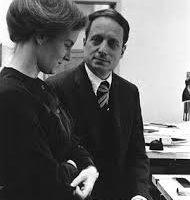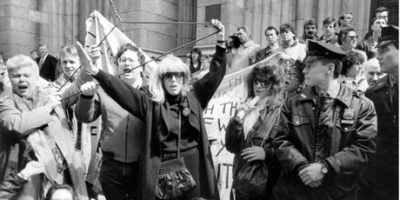Jews and Tattoos
Jews have had a heinous association with tattoos: millions were marked, against their will, as they filed through the gates of concentration camps that dotted Europe like the spores of a horrific and malignant disease. Even after the survivors were liberated, the incised blue numbers remained, silent yet eloquent witnesses to the systematic process of dehumanization of which they were only a part.
Fast forward to Margot Mifflin’s recently reissued Bodies of Subversion: A Secret History of Women and Tattoos, a brilliant and compulsively readable volume that offers an alternative range of meanings: tattoo as a symbol of empowerment, of catharsis, or as a way of establishing new boundaries for the female body. And one of the featured subjects, Marina Vainshtein, will no doubt cause you to reexamine any ideas you might have had on the topic of Jews and tattoos.
Vainshtein, who these days goes by the name of Spike, was born in the Soviet Union and came to the United States when she was four. She was raised in California, and in the early 1990s, when she was eighteen, began having explicit Holocaust imagery tattooed on her skin. Now, more than twenty years later, she is covered. Mifflin lists these tattoos in some detail: a smoke-belching crematorium, naked bodies hanging from gallows, an old woman chained to a coffin of nails, an escaped inmate dying on a electrified fence, a can of Zyklon B (used in gas chambers), a skeleton in an open casket reading kaddish, a Star of David, and, in Hebrew, the words, “Earth hide not my blood” (from the book of Job) and “Never Forget.” Using her body as both her sounding board and her canvas, Vainshtein has totally subverted both the imagery and the process: her tattoos are chosen and worn with pride, not shame, and they delineate aspects of her heritage in a graphic, unmistakable way — she is the granddaughter of survivors. When questioned about her unusual choice, Mifflin quotes Vainshtein as saying, “Why not have external scars to represent the internal scars?” Mifflin posits that even those born long after the Holocaust still suffer psychic damage — and pain.
But Vainshtein is not the only marked woman you’ll meet here. There is Nora Hildebrandt, who was tattooed by her common law husband Martin in 1882, a decade before the first tattooing machine, and Irene Woodward, who died in 1915 and boasted a body covered in 400 tattoos. One woman got a tattoo after her divorce, saying she wanted, “to have a mark on my body that my husband has never seen.” Another did it as a way to explain the “difference” she felt as a lesbian. Still another covered her mastectomy scars with tattooed images of flowers, fish, a heart and a series of eight phases of the moon.
Mifflin points out that now, for the first time in history, women who are tattooed outnumber men; according to a Harris poll, 23% of women wear tattoos as opposed to 19% of men. And women are becoming tattoo artists as well, venturing boldly into territory that used to be an exclusively male domain. Mifflin believes that women tattoo artists perceive a different relationship between subject and image, and are more likely to urge the would-be tattoo wearer to choose an image that truly resonates with her.
Even those who have no desire for a tattoo of their own (and I include myself in this group) will be by turns astonished, fascinated, and moved by the depth and scope of this venerable tradition. And Jewish women in particular will have ample reason to consider the unique example set by Marina Vainshtein and re-evaluate what these words of ink mean to the people of the book.
Yona Zeldis McDonough Lilith’s fiction editor. Her most recent novel is Two of a Kind.




